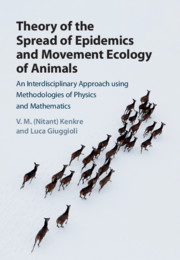
-
Select format
-
- Publisher:
- Cambridge University Press
- Publication date:
- January 2021
- January 2021
- ISBN:
- 9781108882279
- 9781108841405
- Dimensions:
- (244 x 170 mm)
- Weight & Pages:
- 0.73kg, 330 Pages
- Dimensions:
- Weight & Pages:
You may already have access via personal or institutional login
Book description
Exploiting powerful techniques from physics and mathematics, this book studies animal movement in ecology, with a focus on epidemic spread. Pulmonary syndrome is not only feared in epidemics of recent times, such as COVID-19, but is also characteristic of epidemics studied earlier such as Hantavirus. The Hantavirus is one of the book's central topics. Correlations between epidemic outbreaks and precipitation events like El Niño are analyzed and spatial reservoirs of infection in off-period of the epidemic, known as refugia, are studied. Predicted traveling waves of infection are successfully compared to field observations. Territoriality in scent-marking animals is presented, with parallels drawn with the theory of melting. The flocking and herding of birds and mammals are described in terms of collective excitations. For scientists interested in movement ecology and epidemic spread, this book provides effective solutions to long-standing problems.
Reviews
'These authors have successfully written for adventurous interdisciplinary investigators who seek to understand how physics and biology can be combined to understand and develop effective strategies for disease containment. It would be difficult to find a more appropriate book for understanding and addressing the current pandemic … Highly recommended.’
M. Schaab Source: Choice
‘In my opinion, the book is well and balanced writing. The mathematical background given in Chapter 1 and in the 'A Technical Appendix' makes the book almost self-contained, which is very convenient for the readers.’
Andrey Zahariev Source: zbMATH
Contents
Metrics
Full text views
Full text views help Loading metrics...
Loading metrics...
* Views captured on Cambridge Core between #date#. This data will be updated every 24 hours.
Usage data cannot currently be displayed.
Accessibility standard: Unknown
Why this information is here
This section outlines the accessibility features of this content - including support for screen readers, full keyboard navigation and high-contrast display options. This may not be relevant for you.
Accessibility Information
Accessibility compliance for the PDF of this book is currently unknown and may be updated in the future.


